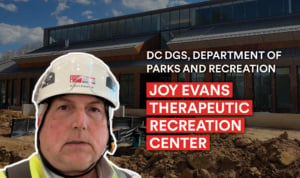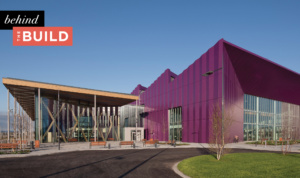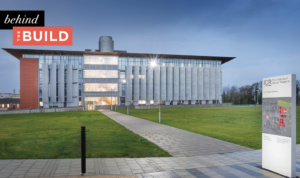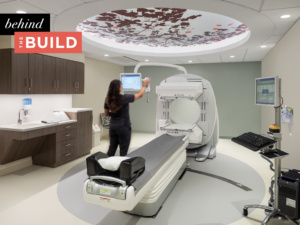Behind the Build: Hilton Arlington National Landing

MGAC was founded with the promise to take on the most interesting and challenging project ideas and make them a reality. Getting there is a matter of a million small steps, countless conversations, a multitude of carefully-calibrated decisions that take place between Day One and that long-awaited project delivery day. Those are the moments that make a project. We’re revisiting them as we delve into the ways our talented, passionate team makes each of our projects possible. Today, we go Behind the Build and revisit our work on the Hilton Arlington National Landing.
Hilton Arlington National Landing from Visiting Media on Vimeo.
In 2019, Starwood Capital Group enlisted our project management support in implementing a Property Improvement Plan on its recently acquired Hilton Crystal City, a circa-1974 hotel in a well-positioned pocket of the Washington, DC area. The project was designed to maintain Hilton’s category-leading status and ensure even better guest stays for years to come.
The work, spanning soft goods upgrades to all 393 guestrooms and suites, modernization of 24,500 SF of meeting space and ballrooms, expansion of the reception and lobby bar, and relocation of the fitness center, was well-timed. The vibrant area the hotel called home—a gateway to the city located less than one mile from Reagan National Airport and the Pentagon, and just four miles from the White House—was undergoing something of a transformation itself. On the heels of Amazon announcing its HQ2 would be based there, a reimagining of the area, now known as “National Landing,” was underway.
Galvanized by the rebrand of its home turf and transformed through the Property Improvement Plan’s guest-minded upgrades, Hilton Crystal City turned one more page in its 50-year history and was officially renamed Hilton Arlington National Landing. This year, as the property celebrates half a century, we’re revisiting how the project brought the building into its own.
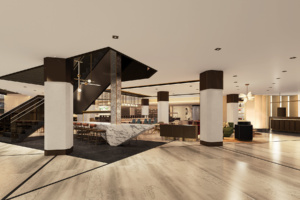
EXECUTING A HOTEL RENOVATION—WHILE IN OPERATION
Hotel renovations can’t occur in a vacuum. There is no remote work plan to enlist, no satellite location to turn to. In fact, most hospitality upgrades are fundamentally challenged with the very reason for the sector’s existence: ensuring guest satisfaction through a seamless execution of expertise, no matter the stakes. Simply put, it’s critical the building remains operational, without compromising the guest experience, even as complex improvements are underway.
This three-year project would touch nearly every square inch of the building, as the job included updates to the concrete structure, each and every guestroom, the lobby, ballrooms, meeting rooms, restaurant, bar, and fitness center. While impossible to keep some of our work under the radar—concrete restorations call for jackhammers, elevator modernizations take entire cars offline for periods of time—there were important variables we could control and critical efforts we knew would make a difference.
We started by getting to know the hotel team through site visits and conversations about pain points, forging relationships with them starting on Day One. We saved critical time and resources through strategic early planning efforts. And we sought efficiencies in our work at every turn—because the sooner we wrapped, the sooner the hotel team could get back to doing what they do best.
DOING OUR DUE DILIGENCE
A 1970s-era building is hardly antique, but 50 years is a substantial age in the life of a hotel thanks to the building’s constant use. When a new hotel owner takes on a renovation—particularly on a structure of this age—there is often much to address, and unknowns become the norm. With this in mind, we invested nearly a year working through the scope with Starwood, deep-diving into all nuances—both planned and otherwise. While this project was prompted by the need for a soft goods renovation, we immediately uncovered the need for additional fundamental maintenance, adding to the already robust scope of work. We initiated a value engineering process to focus our efforts and ensure all core project elements could be completed.

OLD BUILDINGS, NEW ADVENTURES
One of this renovation’s most challenging tasks was, in many ways, its most fundamental: concrete restoration. With the entire building constructed from concrete, a substantial amount of repair work was necessary—so much so that specialized contractor Concrete Protection & Restoration Inc. was brought on to execute it. While concrete may have a reputation for being permanent and impervious, this job taught us anything but. The restoration ran the full course of our work, and successfully delivering this project cornerstone demanded our team learn more about the material than we’d ever dreamed.
In the world of hospitality, success dwells in the details. While many project facets involved immediately visible improvements, others were seemingly small—but only to the untrained eye. For behind what some might consider to be minor details lie game-changing outcomes.
In this case, that “minor detail” would be hot water. Via our early site visits and conversations with the hotel team, we learned that the most-cited guest complaint over the years had been a lack of reliable hot water in rooms. The culprit: an antiquated steam-powered system that couldn’t keep up with the needs of the building. Though not part of the original project scope, we recognized that addressing this would be a critical element of success. Project leaders swiftly hired mechanical engineers Shapiro & Duncan to explore the system and establish a solution within budget. Ultimately, they deemed the best course of action to be designing a replacement domestic hot water system.
As it turns out, that would be the easy part. With the hotel remaining in operation throughout the project, it was impossible to shut off the existing system and install the new one. Our workaround? Replace the entire system, one portion at a time, overnight. Needless to say, the monumental effort was a first for our team. But the transformation in guest satisfaction—and, in turn, that of the hotel team—has been nothing short of monumental too.

REALIZING A PROPERTY’S FULL POTENTIAL
A hotel’s entrance is the gateway to a guest’s experience. As such, it was a focal point of our work here. Thanks to the conversion of existing office space into valuable lobby space, an expansion of the existing bar, and relocation of the restaurant to better capture foot traffic, the lobby now affords an openness and natural flow it never had before. As guests check in, they’re beckoned to grab a drink or a quick bite before relaxing in their room, attending to important business, or hitting the city. An original grand staircase with glass hand railing, once boxed in and hidden, was also opened up and enlivened, now serving dual purpose as a functional feature and design showpiece as it frames a communal table and new sparkling chandelier.
In other areas of the hotel, guests can expect an abundance of world-class features. A Peloton Wellness Room includes a Peloton Spin Bike and Therabody Theragun Elite and Wave Roller, in addition to other wellness amenities. Meanwhile, a new workspace is equipped with a built-in desktop monitor, wireless keyboard, wireless mouse, and wireless phone charger for business travelers seeking a well-connected space to get to work.
National Landing attracts millions of visitors every year, and through this project, the hotel has been revealed for all it could be, even after decades in business and countless guest stays. As it rings in 50, it’s safe to say Hilton Arlington National Landing—in many ways, National Landing’s “newest” hotel—is just getting started.


